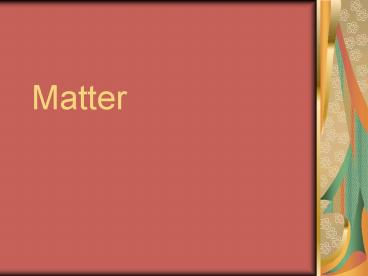Matter - PowerPoint PPT Presentation
1 / 31
Title:
Matter
Description:
Heat and light ARE NOT matter because they do not have mass ... `There's antimony, arsenic, aluminum, selenium, And hydrogen and oxygen and nitrogen and rhenium ... – PowerPoint PPT presentation
Number of Views:27
Avg rating:3.0/5.0
Title: Matter
1
Matter
2
Vocabulary
- Matter
- Atom
- Element
- Proton
- Neutron
- Nucleus
- Electron
- Atomic Number
- Mass Number
- Isotope
- Compound
- Ion
- Mixture
- Heterogeneous Mixture
- Homogeneous Mixture
- Density
3
What do water, ice, and steam have in common?
http//video.google.com/videoplay?docid-126156650
3477585548
4
Matter
- Heat and light ARE NOT matter because they do not
have mass or take up space. - If all the objects you see are matter, why do
they look so different? - Anything that has mass and takes up space.
5
Mass
- Loosely defined as the amount of matter an object
contains.
6
Atoms
- If all the articles you see are made up of
matter, why do they look so different? - The structure of different atoms and how they are
joined together determine the properties of
matter. - The building blocks of matter are atoms.
- The tiny particles that make up all matter are
atoms.
7
Lithium Atom
8
Parts of an Atom
9
(No Transcript)
10
(No Transcript)
11
(No Transcript)
12
(No Transcript)
13
(No Transcript)
14
(No Transcript)
15
(No Transcript)
16
Electrons
17
What is an accelerator, and How does it work?
- http//education.jlab.org/sitetour/index.html
18
Elements
- Substances that are made of only one type of atom
and cannot be broken down by normal chemical or
physical means. - Native elements are minerals consisting of one
element found in the earths crust.
19
Sing Along to the Elements ?
20
Lyrics to the Elements Song ?
- It's simply the names of the chemical elements
set to a possibly recognizable tune. - There's antimony, arsenic, aluminum, selenium,
And hydrogen and oxygen and nitrogen and rhenium
And nickel, neodymium, neptunium, germanium,
And iron, americium, ruthenium, uranium,
Europium, zirconium, lutetium, vanadium And
lanthanum and osmium and astatine and radium And
gold, protactinium and indium and gallium
(inhale) And iodine and thorium and thulium and
thallium. - There's yttrium, ytterbium, actinium, rubidium
And boron, gadolinium, niobium, iridium And
strontium and silicon and silver and samarium,
And bismuth, bromine, lithium, beryllium and
barium.
21
- Isn't that interesting? I knew you would. I
hope you're all taking notes, because there's
gonna be a short quiz next period. - There's holmium and helium and hafnium and
erbium And phosphorous and francium and fluorine
and terbium And manganese and mercury,
molybdinum, magnesium, Dysprosium and scandium
and cerium and cesium And lead, praseodymium,
and platinum, plutonium, Paladium, promethium,
potassium, polonium, and Tantalum, technetium,
titanium, tellurium, (inhale) And cadmium and
calcium and chromium and curium. - There's sulfur, californium and fermium,
berkelium And also mendelevium, einsteinium and
nobelium And argon, krypton, neon, radon, xenon,
zinc and rhodium And chlorine, carbon, cobalt,
copper, Tungsten, tin and sodium. - These are the only ones of which the news has
come to Harvard, And there may be many others
but they haven't been discovered.''
22
The Periodic Table of Elements
23
Periodic Table of the Elements
The periodic table was invented by the Russian
chemist Dmitri Mendeleyev (1834-1907), which he
published in Principles of Chemistry in 1869. His
periodic table arranged the 63 known chemical
elements in order of their atomic mass. Today,
the elements in the periodic table are ordered by
their atomic number.
24
Some of the groups are
- Group IA Alkaline metals
- Group IIA Alkaline Earth metals
- Group IIIA Light metals
- Group IVA Carbon family
- Group VA Nitrogen family
- Group VIA Chalcogen (Oxygen) family
- Group VIIA Halogens
- Group VIIIA Noble Gases
25
How to Read the Periodic Table
Group
Period
26
How to Read the Periodic Table
- Groups or Families
- The vertical columns of the periodic table (there
are 18) are called groups or families. Elements
in the same group or family have similar but not
identical characteristics. - Periods
- The horizontal rows of the periodic table are
called periods. Elements in a period are not
alike in properties.
27
Metals, Nonmetals, Metalloids
28
Metals, Nonmetals, Metalloids
- Metals
- Most elements are metals. 88 elements to the left
of the stairstep line are metals or metal like
elements - Nonmetals
- Nonmetals are found to the right of the stairstep
line. - Metalloids
- Elements on both sides of the zigzag line have
properties of both metals and nonmetals.
29
Symbol
Element
Atomic Mass
- The number of protons equals the atomic number.
- In a neutral atom, the number of protons is
equal to the number of electrons. - The mass number of an atom is equal to the number
of protons plus the number of neutrons.
30
Mass Number
31
- http//www.teachnet.ie/macalvey/atomic20mumber.ht
mcalculating































